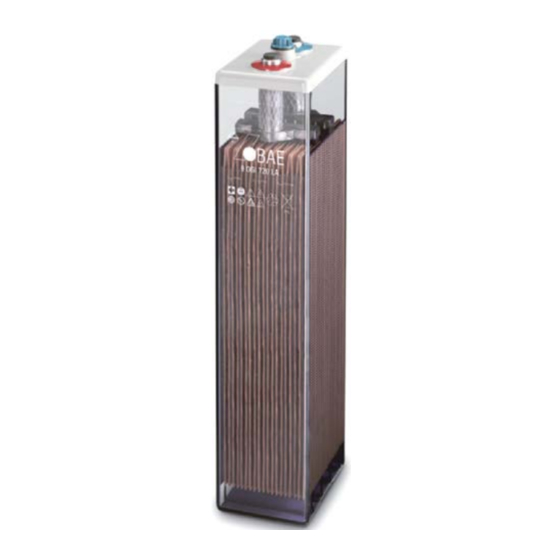Summary of Contents for BAE OPzS Series
- Page 1 STATIONARY BAE BATTERIES: Vented Lead Acid (VLA) / Flooded Installation and Operating Instructions OPzS & OGi Series Batteries Important Documents - Do Not Discard...
-
Page 2: Introduction
Stationary Vented Lead Acid (VLA) Batteries, Installation and Operating Instructions This publication defines the essential requirements for the proper storage, handling, assembly, commissioning, operation, and maintenance of the BAE OPzS and OGi stationary vented lead-acid batteries. 1.0 SAFETY PRECAUTIONS & WARNINGS •... -
Page 3: Electrolyte Hazards
Stationary VLA Batteries, Installation and Operation Instructions 1.1 ELECTROLYTE HAZARDS The electrolyte is dilute sulfuric acid, which is harmful to skin, and eyes. It is electrically conductive and corrodes unprotected metal surfaces. PRECAUTIONS a) When handling electrolyte wear full eye protection, rubber or plastic gloves, apron and boots. -
Page 4: Table Of Contents
Stationary VLA Batteries, Installation and Operation Instructions TABLE OF CONTENTS: INTRODUCTION ………………………………………………………………………………........1 1.0 SAFETY PRECAUTIONS & WARNINGS ………………………..………………………………..……...……. 1 1.1 ELECTROLYTE HAZARDS ……………………………………………………...……………………..…. 2 1.2 ELECTRICAL HAZARDS ……………………………………………………………………..…………………. 1.3 EXPLOSIVE GASES ………………………………………………………………………..……………………. 2 TABLE OF CONTENTS ………………………………………………………………………………………...……... 3 2.0 RECEIVING OF STATIONARY BATTERIES ………………………………………………....…... 4 2.1 VISIBLE EXTERNAL DAMAGE…………………………………………………………………..……...….. -
Page 5: Receiving Of Stationary Batteries
If any of the above are observed, make a note of it on the bill of lading before signing. NOTE: Shipping damage must be handled with the carrier -- not BAE Batteries USA 2.2 CONCEALED DAMAGE It is recommended that the cells be unpacked and checked for concealed damage as soon as possible. -
Page 6: Accessories
As a battery loses charge, its specific gravity decreases causing it to have a higher freezing temperature. The freezing temperature versus specific gravity is shown in the table below. BAE VLA batteries have a specific gravity of 1.240 kg/l at 68°F. -
Page 7: Unpacking-Handling
If the level is below the minimum line, check the container for damage. If your visual inspection, after unpacking, indicates damaged posts, cell covers or jars, or electrolyte levels are below the minimum line immediately contact BAE USA or your local representative. -
Page 8: Racks (Existing Rack)
Make sure the rail insulation is clean and in place. d) If the existing rack is not designed for the new batteries being installed this could affect your seismic rating and battery warranty. Please contact BAE USA or your local representative with questions. -
Page 9: Terminal Preparation
All bolted connections should be made using a calibrated torque wrench to insure proper tightness of the connection without causing any damage to the battery posts. The torque settings for both of BAE bolt types (M10 Allen and 17mm Hex) is: • 22 Newton-meters or 195 (194.7 actual) inch-pounds. -
Page 10: Terminal Plates
The electrolyte level should be between the maximum and minimum level lines on the container. If for any reason electrolyte was lost during installation, contact BAE USA or your local representative. -
Page 11: Commissioning - Supplied Wet And Charged
If OCV is < 2.075V but ≥ 2.065V, then a higher boost charge as defined in 7.0.2 will be required o If OCV is < 2.065V contact BAE USA or your local representative. Once the pre-commissioning charge measurements are completed, the commissioning charge can begin. -
Page 12: Commissioning With Float Charge Voltage - 2.23 Vpc
(Specific Gravity) at the maximum electrolyte level at a fully charged condition: Single Cell Nominal Specific Gravity and Tolerance for the BAE OGi and OPzS Cells: 1.240 ±0.01 kg/l at 25°C (77°F); yielding a range of 1.230 to 1.250 kg/l Note that the level of electrolyte in the cell will affect the reading –... -
Page 13: Charging Currents
8.3 CHARGING CURRENTS The charging current on the BAE cells does not need to be limited until the battery voltage has reached 2.40 VPC x number of cells - thereafter the charging current has to be limited to 5A per 100 Ah of battery capacity. -
Page 14: Recharging Cycle
In certain circumstances, specific cleaners may be used. However, you must consult with BAE USA or your local representative prior to use. If approved, after application of the cleaner the cell should be rinsed with water and thoroughly dried with a clean damp cloth. -
Page 15: Periodic Inspections
Stationary VLA Batteries, Installation and Operation Instructions Required table of impurities for purified water for adding to cells: Impurity Max mg/L Evaporation residue Oxidable organic substances, calculated as KMnO4-consumption. Metals of the hydrogen sulphide group (Pb, Sb, As, Sn, Bi, Cu, Cd) Per element Together Metals of the ammonium sulphide group (Fe, Co, Ni, Mn, Cr) -
Page 16: Individual Cell Voltages
2.23; this gives us a range of 2.18 to 2.33 volts If the individual cell voltages are not within the allowable tolerances, measure and record the specific gravity readings of those cells and contact BAE USA or your local representative. - Page 17 • The timing of the corrective action for increased connection resistance should be determined by an analysis of the effects of the increased resistance. Consult BAE USA or your local representative if there are questions.
- Page 18 IEEE 450 or contact BAE USA or your local representative. 11.0.8 If the target capacity is not achieved, we request that you contact BAE USA or your local representative. It is generally recommended that if the measured capacity of the battery is less than 80% the battery should be considered for replacement.




Need help?
Do you have a question about the OPzS Series and is the answer not in the manual?
Questions and answers